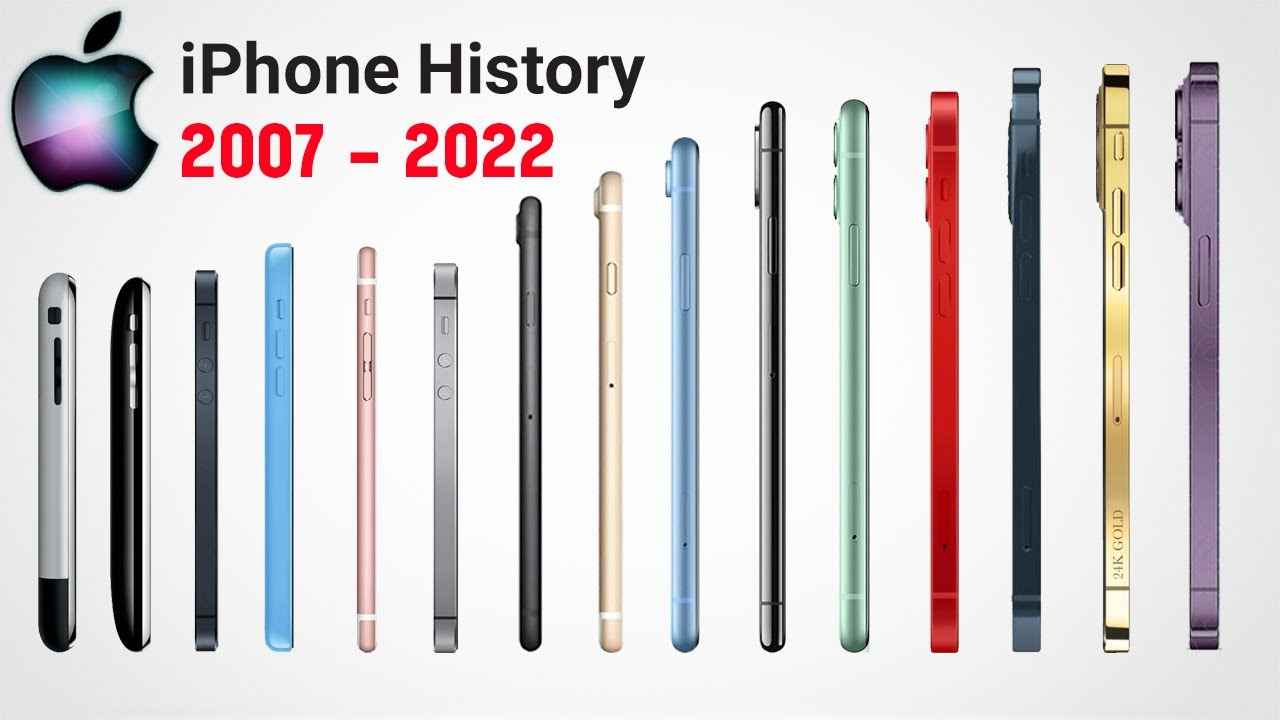The Complete History of Apple iPhones | The iPhone is a line of smartphones designed and marketed by Apple Inc. The first iPhone was announced by then-CEO Steve Jobs on January 9, 2007, and was released on June 29, 2007. The iPhone runs Apple’s iOS mobile operating system.
The first-generation iPhone was a GSM phone and established design precedents, such as a button placement that has persisted throughout all releases and a screen size maintained for the next four iterations. The iPhone 3G added 3G cellular network capabilities and A-GPS location. The iPhone 3GS added a compass, faster processor, and higher resolution camera, including video recording at 480p. The iPhone 4 introduced a new hardware design, the Apple A4 system-on-chip, an improved display resolution, and front-facing camera. The iPhone 4S introduced Siri, a personal assistant that uses voice commands.
READ ALSO | Tube Mastery and Monetization by Matt Par
The iPhone 5 featured a taller, 4-inch display, and Apple’s newly introduced Lightning connector. The iPhone 5C, a mid-range-priced version of the handset that is designed to increase accessibility due to its price is plastic and came in five colors (green, blue, yellow, pink, and white). The iPhone 5S included major internal upgrades, including an A7 64-bit system-on-chip, and an improved camera along with a fingerprint recognition feature.
The iPhone 6 and iPhone 6 Plus were released on September 19, 2014. The iPhone 6 has a 4.7-inch display, while the iPhone 6 Plus has a 5.5-inch display. Both models include an updated A8 processor and improved rear-facing and front-facing cameras.
The iPhone 6S and iPhone 6S Plus were announced on September 9, 2015, and were released on September 25, 2015. They came with improved hardware, including the A9 processor and improved cameras, as well as the introduction of 3D Touch, which provides pressure-sensitive touch inputs.
The iPhone 7 and iPhone 7 Plus were announced on September 7, 2016, and were released on September 16, 2016. They feature improved system and graphics performance, a new dual-camera setup on the Plus model, new color options, and the removal of the 3.5 mm headphone jack.
The iPhone 8 and iPhone 8 Plus were announced on September 12, 2017, and were released on September 22, 2017. They featured wireless charging, improved system and graphics performance, and a new glass design.
The iPhone X was announced on September 12, 2017, and was released on November 3, 2017. It featured a new design with a nearly edge-to-edge display, Face ID facial recognition technology, and improved cameras.
The iPhone XR, XS, and XS Max were announced on September 12, 2018, and released on September 21, 2018. The iPhone XR features a 6.1-inch “Liquid Retina” LCD display, while the XS and XS Max feature 5.8-inch and 6.5-inch “Super Retina” OLED displays, respectively. All three models feature the A12 Bionic chip and improved cameras.
The iPhone 11, 11 Pro and 11 Pro Max were announced on September 10, 2019, and were released on September 20, 2019. These models came with A13 bionic chip, improved dual and triple camera setup, night mode and slo-mo video recording, and improved battery life.
READ ALSO | Exipure Weight Loss Supplement – Exipure Reviews 2023
The iPhone SE (2nd generation) was announced on April 15, 2020, and released on April 24, 2020. It has the same A13 bionic chip as the iPhone 11 and improved cameras, but with a 4.7-inch LCD display, similar to the iPhone 8.
The iPhone 12, 12 Mini, 12 Pro, and 12 Pro Max were announced on October 13, 2020, and were released on October 23, 2020. They feature 5G connectivity, A14 Bionic chip, improved camera systems and Ceramic Shield technology. They also have a new design with flat-edge stainless steel edges, similar to the iPhone 4 and 5. The Mini and 12 have a 6.1-inch display, while the Pro models have 6.1-inch and 6.7-inch OLED display respectively.
In addition to the new models, Apple also released a new HomePod mini which is smaller and more affordable version of the original HomePod.
On April 20, 2021, Apple announced the iPhone 13, 13 Mini, 13 Pro, and 13 Pro Max which will be released on September 24, 2021. These models feature 5G connectivity, A15 Bionic chip, improved camera systems, ProMotion display, and Face ID technology, which allows users to unlock the phone by simply looking at it. The Mini and 13 have a 6.1-inch display, while the Pro models have 6.1-inch and 6.7-inch OLED display respectively.
That concludes the history of the iPhone, from its first release in 2007 until 2021. The iPhone has undergone several changes and improvements over the years, with new features and designs being added with each new release.
The iPhone has also had a significant impact on the technology industry and society as a whole. It popularized the use of smartphones, and it’s touch-based interface and app store paved the way for the mobile apps that we use today. The iPhone’s camera, particularly the one on the latest iPhone models, is considered one of the best in the smartphone market, and its high-resolution display and smooth performance make it a favorite among users.
The iPhone’s success has also had a significant impact on Apple’s financial performance, with the iPhone contributing to the majority of Apple’s revenue. The iPhone is one of the most recognizable and popular consumer technology products in the world and it continues to be one of the most sought-after devices on the market.
Apple has also been known to provide regular software updates for all its iPhone models, which includes new features and security updates, making them more secure and user-friendly over time. The iPhone has also been an important tool for businesses and professionals, as it allows them to stay connected and productive while on the go.
Overall, the iPhone has had a significant impact on the technology industry and has changed the way we communicate, take photos and videos, play games, and access information. Its continued success and popularity are a testament to the innovation and design that goes into each new release.
READ ALSO | Top 10 Best Smartwatches Under 10000 In India – Buyer’s Guide Review
- First-generation iPhone (2007)
- iPhone 3G (2008)
- iPhone 3GS (2009)
- iPhone 4 (2010)
- iPhone 4S (2011)
- iPhone 5 (2012)
- iPhone 5C (2013)
- iPhone 5S (2013)
- iPhone 6 (2014)
- iPhone 6 Plus (2014)
- iPhone 6S (2015)
- iPhone 6S Plus (2015)
- iPhone SE (2016)
- iPhone 7 (2016)
- iPhone 7 Plus (2016)
- iPhone 8 (2017)
- iPhone 8 Plus (2017)
- iPhone X (2017)
- iPhone XR (2018)
- iPhone XS (2018)
- iPhone XS Max (2018)
- iPhone 11 (2019)
- iPhone 11 Pro (2019)
- iPhone 11 Pro Max (2019)
- iPhone SE (2nd generation) (2020)
- iPhone 12 (2020)
- iPhone 12 Mini (2020)
- iPhone 12 Pro (2020)
- iPhone 12 Pro Max (2020)
- iPhone 13 (2021)
- iPhone 13 Mini (2021)
- iPhone 13 Pro (2021)
- iPhone 13 Pro Max (2021)
- iPhone 14 Plus (2022)
- iPhone 14 Pro (2022)
- iPhone 14 Pro MAX (2022)
Note that this list is based on the official release dates of each iPhone model and that these are the main models that have been released by Apple.
Posted by Talkaaj.com
READ ALSO | 2023 Best Laptop Brands in India Details Review
READ ALSO | Life Insurance: There are 8 types of policies available, take a plan according to your need
If you liked this article then do like and share it.
Thanks for reading this article till the end…
???????? Join Our Group For All Information And Update, Also Follow me For Latest Information???????? |
|
| Click Here | |
| ???? Facebook Page | Click Here |
| Click Here | |
| ???? Telegram | Click Here |
| ???? Koo | Click Here |
| Click Here | |
| ???? YouTube | Click Here |
| ???? Google News | Click Here |















